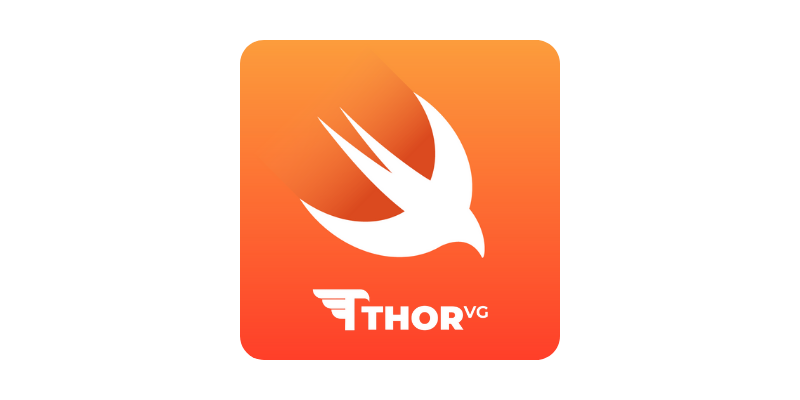ThorVG for Swift is a lightweight wrapper around the ThorVG C++ API, providing native support for vector graphics in Swift applications. This package currently only supports rendering Lottie animations and is actively evolving to include more features.
ThorVG Version: v0.14.7 (commit e3a6bf)
Supported Platforms: iOS (minimum deployment target: iOS 13.0)
To integrate ThorVGSwift into your Swift project, use Swift Package Manager. Simply add the following line to the dependencies section of your Package.swift file:
dependencies: [
// ...
.package(url: "https://github.com/thorvg/thorvg.swift", from: "0.1.0")
]This Swift wrapper currently only supports rendering Lottie animations. As the package evolves, additional support for more content types will be added.
The API of ThorVGSwift closely follows the structure of the original ThorVG API. It enables rendering of Lottie frames to a buffer. Below is a quick guide to help you get started with the essential APIs.
To start, create a Lottie instance using a desired local file path.
let url = Bundle.main.url(forResource: "test", withExtension: "json")
let lottie = try Lottie(path: url.path)If you only have the string data of the Lottie, you can use the alternate String initialiser.
let lottie = try Lottie(string: "...")Next, initialise a buffer for ThorVG to draw Lottie frame data into.
let size = CGSize(width: 1024, height: 1024)
let buffer = [UInt32](repeating: 0, count: Int(size.width * size.height))From here, initialise a LottieRenderer instance to handle the rendering of individual Lottie frames.
let renderer = LottieRenderer(
lottie,
size: size,
buffer: &buffer,
stride: Int(size.width),
pixelFormat: .argb
)Note
You can use different pixel formats including .argb, .rgba, etc. (see the complete list here).
By default, the LottieRenderer runs on the main thread. If needed, you can create a custom Engine with multiple threads.
let engine = Engine(numberOfThreads: 4)
let renderer = LottieRenderer(
lottie,
engine: engine,
size: size,
buffer: &buffer,
stride: Int(size.width),
pixelFormat: .argb
)Once your LottieRenderer is set up, you can start rendering Lottie frames using the render function.
The render function takes three parameters:
frameIndex: the index of the frame to rendercontentRect: the area of the Lottie content to renderrotation(optional): the rotation angle to apply to the renderered frame
let contentRect = CGRect(x: 0, y: 0, width: size.width, height: size.height)
try renderer.render(frameIndex: 0, contentRect: contentRect, rotation: 0.0)And voilà! Your buffer is now filled with the rendered Lottie frame data.
Tip
To render all of the frames in a Lottie animation, you can iterate through the numberOfFrames property of the Lottie class.
Follow these steps to configure your environment and build the ThorVG Swift package in Xcode.
Before building the Swift package in Xcode, make sure to run the setup.sh script:
./setup.shThis script updates the submodule reference and copies the necessary configuration files required for compilation.
Warning
ThorVG uses the Meson build system to generate artifacts, including a config.h file required for compilation.
Since Swift Package Manager needs all files present at compile time, this file must be generated before building.
The setup.sh script handles this by copying a pre-built config.h file into the correct location within the thorvg/src directory.
Important
After running the setup, you'll see a config.h file in the git status of the ThorVG submodule. This is expected, and you can safely ignore this file when reviewing changes or making commits.
Once the setup script is executed, you can successfully build the ThorVG Swift package in Xcode.
Contributions are welcome! If you'd like to help, feel free to open an issue or submit a pull request.
